Functional programming and iteration with purrr
Malcolm Barrett
2019-09-26
1 / 68
Interactive app: malcolmbarrett.shinyapps.io/purrr_exercises
Or try exercises.Rmd in the repo: github.com/malcolmbarrett/lawrug_purrr
2 / 68
purrr: A functional programming toolkit for R
Complete and consistent set of tools for working with functions and vectors
3 / 68
Problems we want to solve:
- Making code clear
- Making code safe
- Working with lists and data frames
4 / 68
Lists, vectors, and data.frames (or tibbles)
c(a = "hello", b = 1)## a b ## "hello" "1"5 / 68
lists can contain any object
list(a = "hello", b = 1, c = mean)## $a## [1] "hello"## ## $b## [1] 1## ## $c## function (x, ...) ## UseMethod("mean")## <bytecode: 0x7fe91ec2c958>## <environment: namespace:base>6 / 68
data frames are lists
x <- list(a = "hello", b = 1)as.data.frame(x)## a b## 1 hello 17 / 68
data frames are lists
library(gapminder)head(gapminder$pop)## [1] 8425333 9240934 10267083 11537966 13079460 148803728 / 68
data frames are lists
gapminder[1:6, "pop"]9 / 68
data frames are lists
gapminder[1:6, "pop"]## # A tibble: 6 x 1## pop## <int>## 1 8425333## 2 9240934## 3 10267083## 4 11537966## 5 13079460## 6 1488037210 / 68
data frames are lists
head(gapminder[["pop"]])## [1] 8425333 9240934 10267083 11537966 13079460 1488037211 / 68
vectorized functions don't work on lists
sum(rnorm(10))12 / 68
vectorized functions don't work on lists
sum(rnorm(10))## [1] -3.83157413 / 68
vectorized functions don't work on lists
sum(rnorm(10))## [1] -3.831574sum(list(x = rnorm(10), y = rnorm(10), z = rnorm(10)))14 / 68
vectorized functions don't work on lists
sum(rnorm(10))## [1] -3.831574sum(list(x = rnorm(10), y = rnorm(10), z = rnorm(10)))## Error in sum(list(x = rnorm(10), y = rnorm(10), z = rnorm(10))): invalid 'type' (list) of argument15 / 68
map(.x, .f)
16 / 68
map(.x, .f)
.x: a vector, list, or data frame
16 / 68
map(.x, .f)
.x: a vector, list, or data frame
.f: a function
16 / 68
map(.x, .f)
.x: a vector, list, or data frame
.f: a function
Returns a list
16 / 68
Using map()
library(purrr)x_list <- list(x = rnorm(10), y = rnorm(10), z = rnorm(10))map(x_list, mean)17 / 68
Using map()
library(purrr)x_list <- list(x = rnorm(10), y = rnorm(10), z = rnorm(10))map(x_list, mean)18 / 68
Using map()
library(purrr)x_list <- list(x = rnorm(10), y = rnorm(10), z = rnorm(10))map(x_list, mean)19 / 68
Using map()
library(purrr)x_list <- list(x = rnorm(10), y = rnorm(10), z = rnorm(10))map(x_list, mean)## $x## [1] -0.6097971## ## $y## [1] -0.2788647## ## $z## [1] 0.616592220 / 68
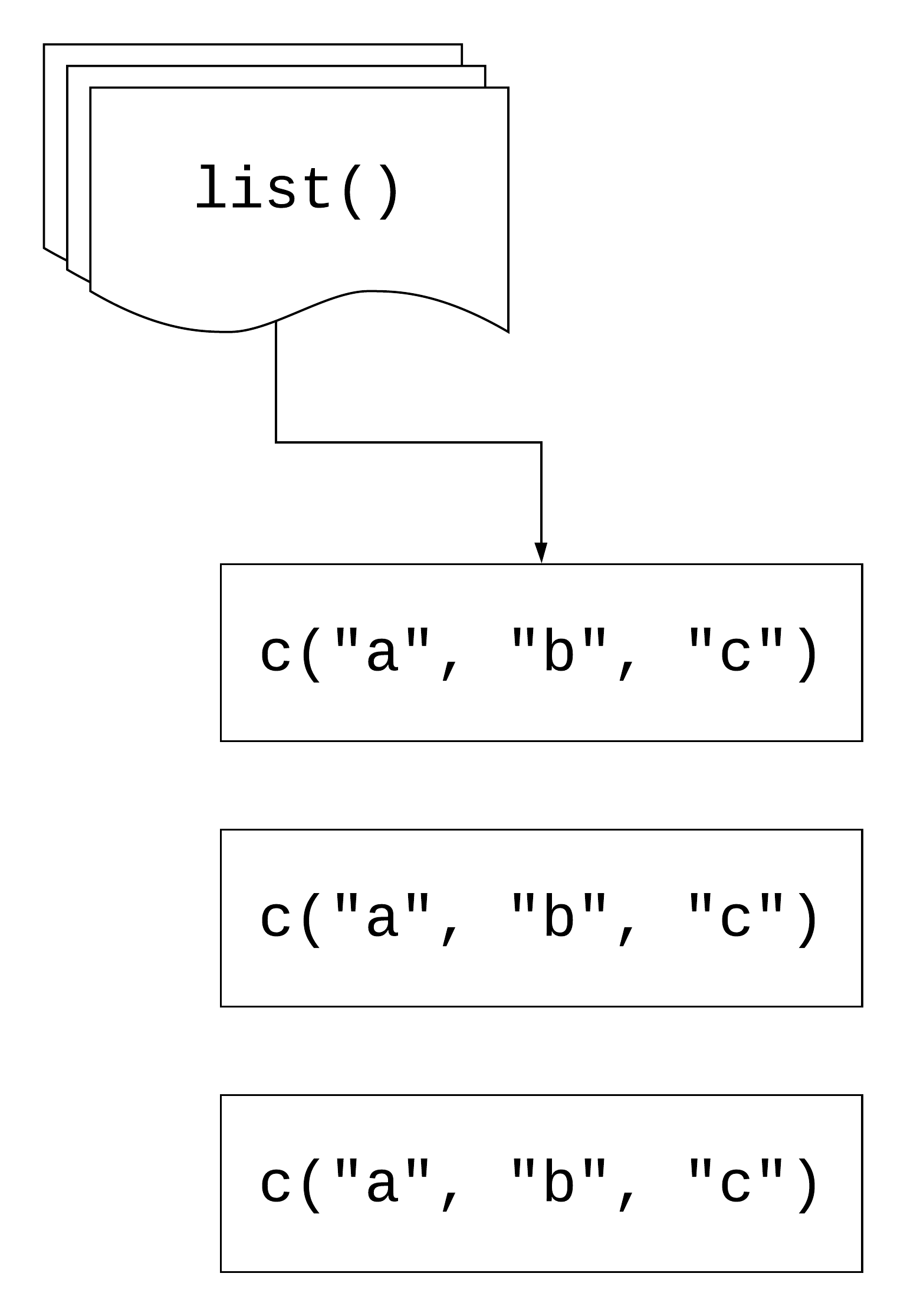
21 / 68
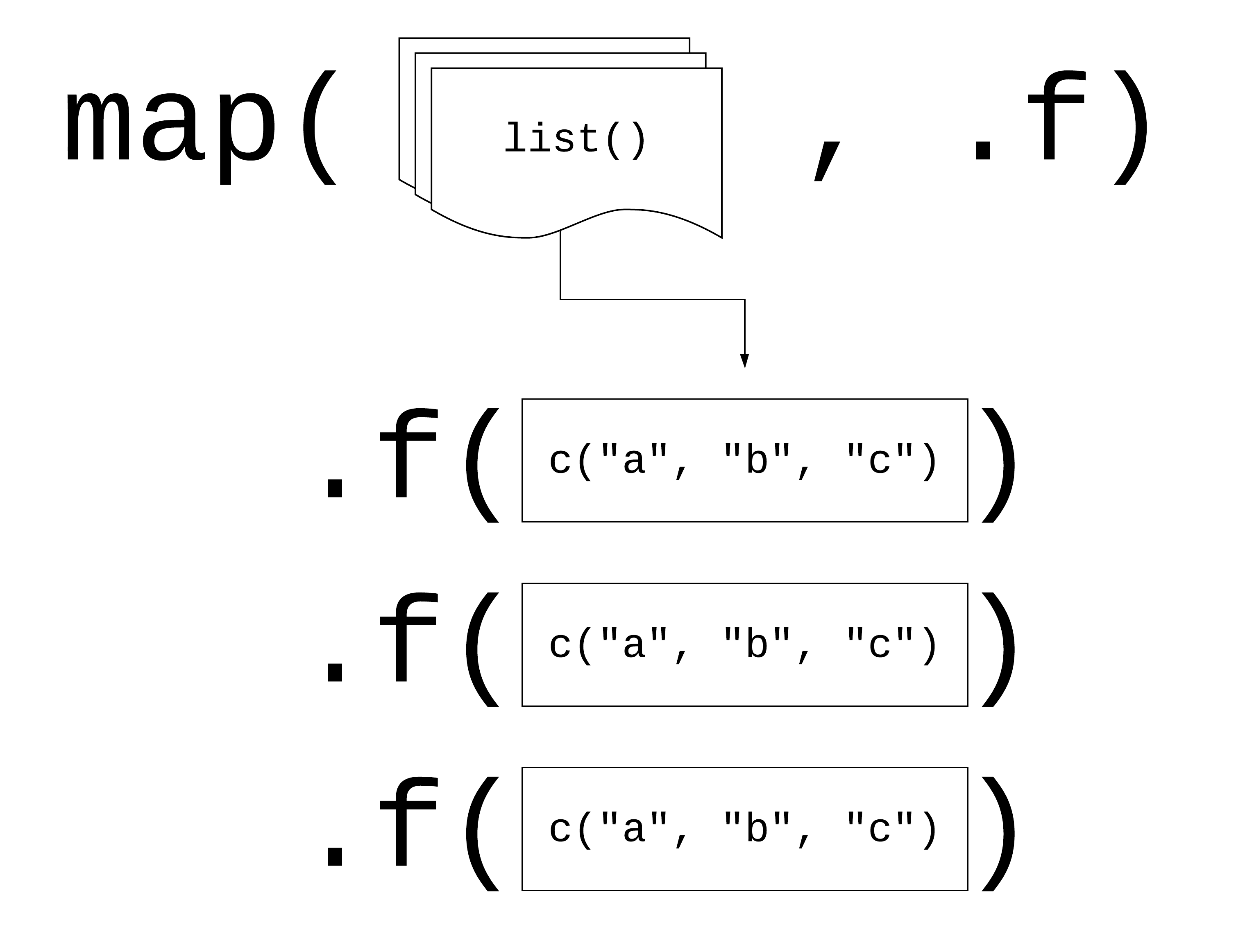
22 / 68
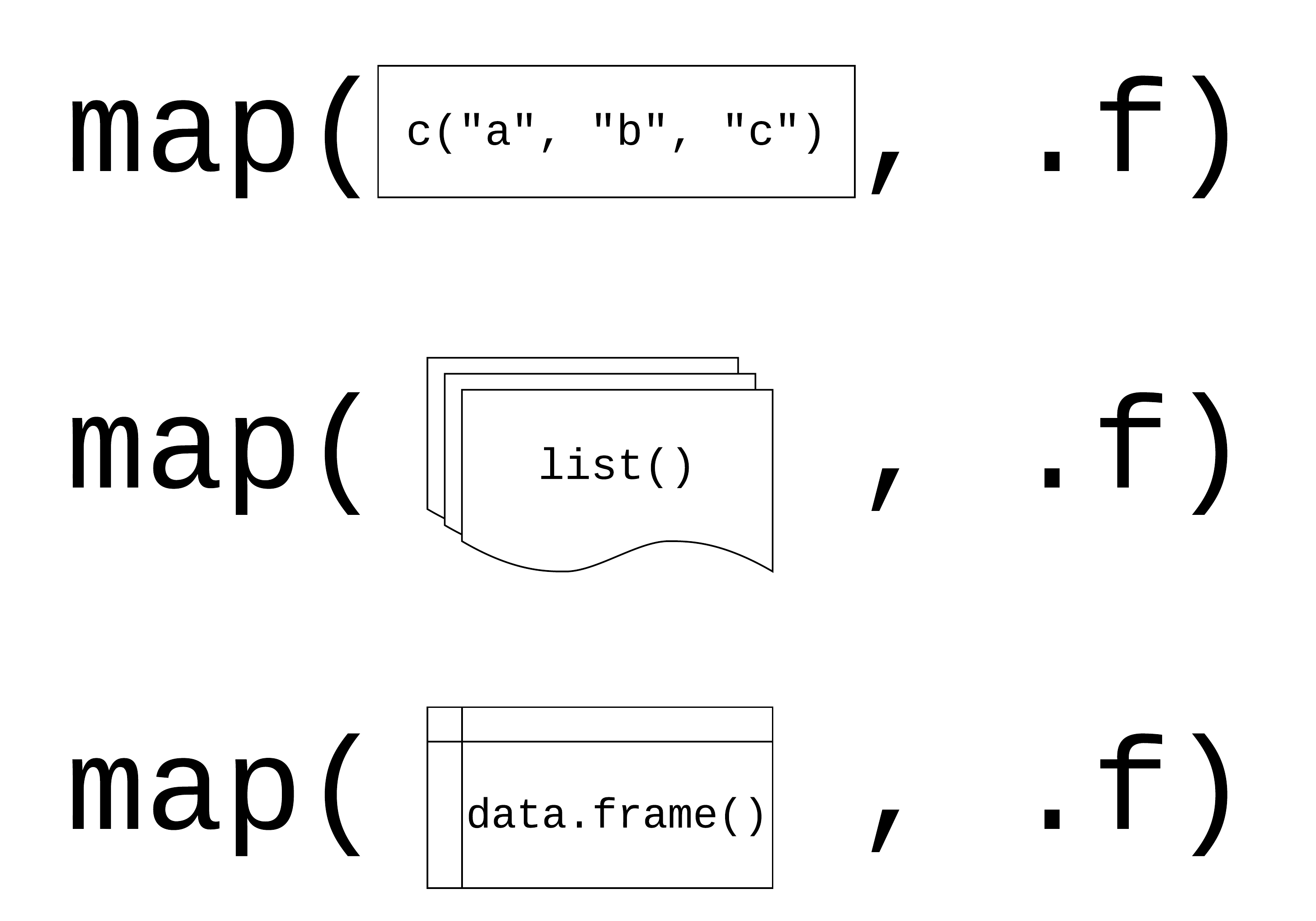
23 / 68
using map() with data frames
gapminder %>% dplyr::select_if(is.numeric) %>% map(sd)## $year## [1] 17.26533## ## $lifeExp## [1] 12.91711## ## $pop## [1] 106157897## ## $gdpPercap## [1] 9857.45527 / 68
Review: writing functions
x <- x^2x <- scale(x)x <- max(x)28 / 68
Review: writing functions
x <- x^2x <- scale(x)x <- max(x)y <- x^2y <- scale(y)y <- max(y)z <- z^2z <- scale(x)z <- max(z)29 / 68
Review: writing functions
x <- x^2x <- scale(x)x <- max(x)y <- x^2y <- scale(y)y <- max(y)z <- z^2z <- scale(x)z <- max(z)30 / 68
Review: writing functions
x <- x^3x <- scale(x)x <- max(x)y <- x^2y <- scale(y)y <- max(y)z <- z^2z <- scale(x)z <- max(z)31 / 68
Review: writing functions
.f <- function(x) { x <- x^3 x <- scale(x) max(x)}.f(x).f(y).f(z)32 / 68
If you copy and paste your code three times, it's time to write a function
33 / 68
Three ways to pass functions to map()
- pass directly to
map() - use an anonymous function
- use ~
34 / 68
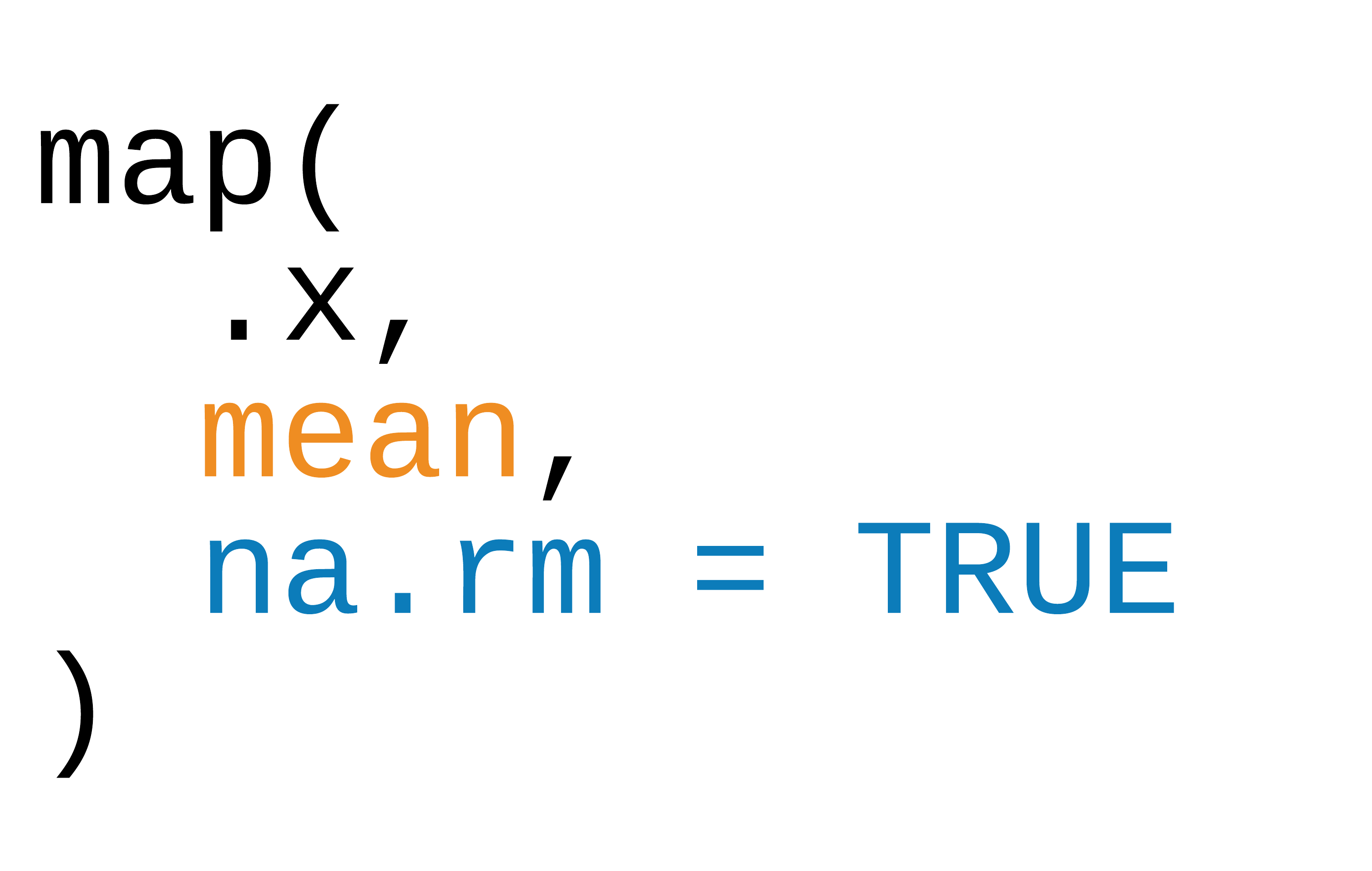
35 / 68
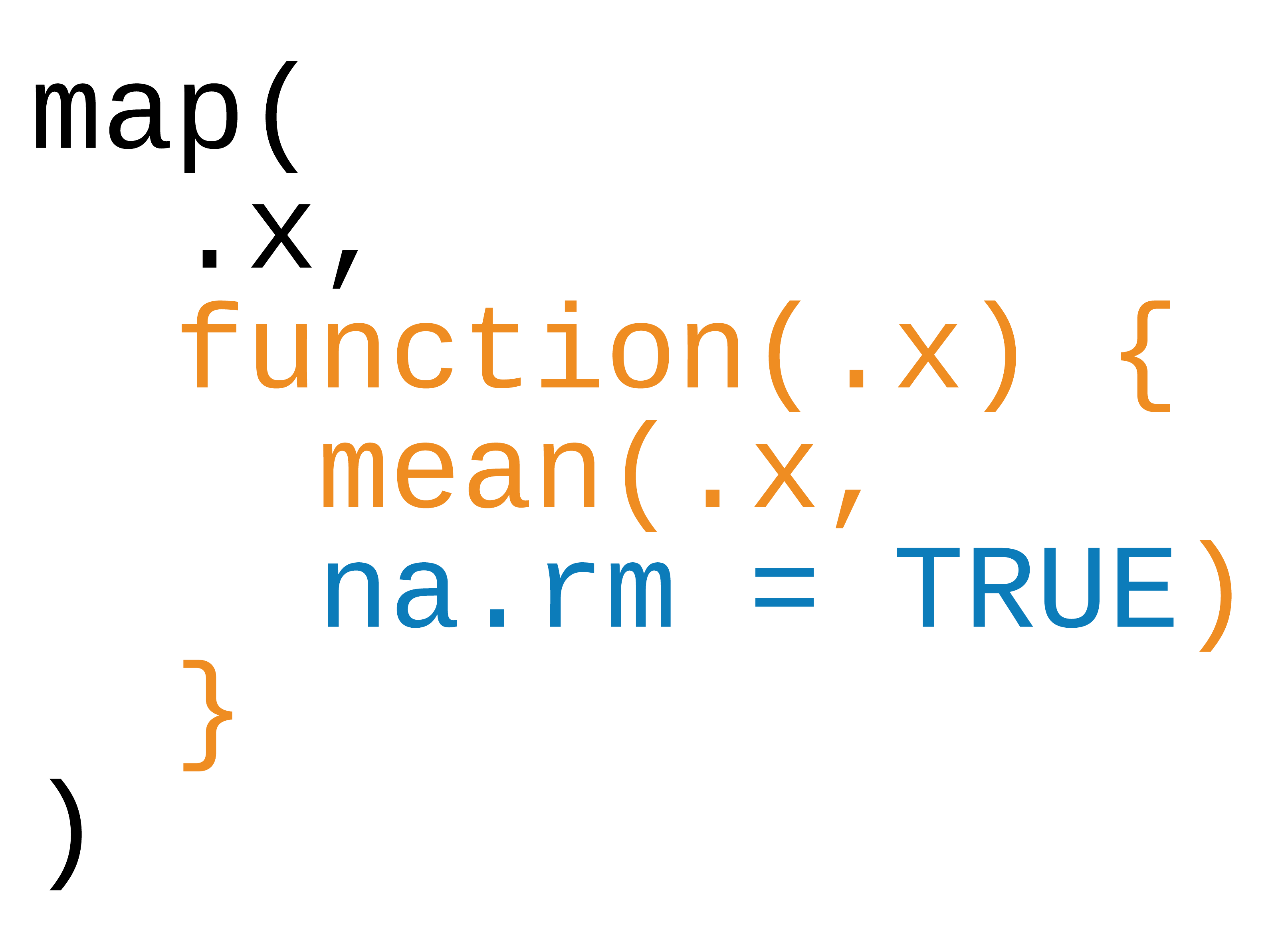
36 / 68
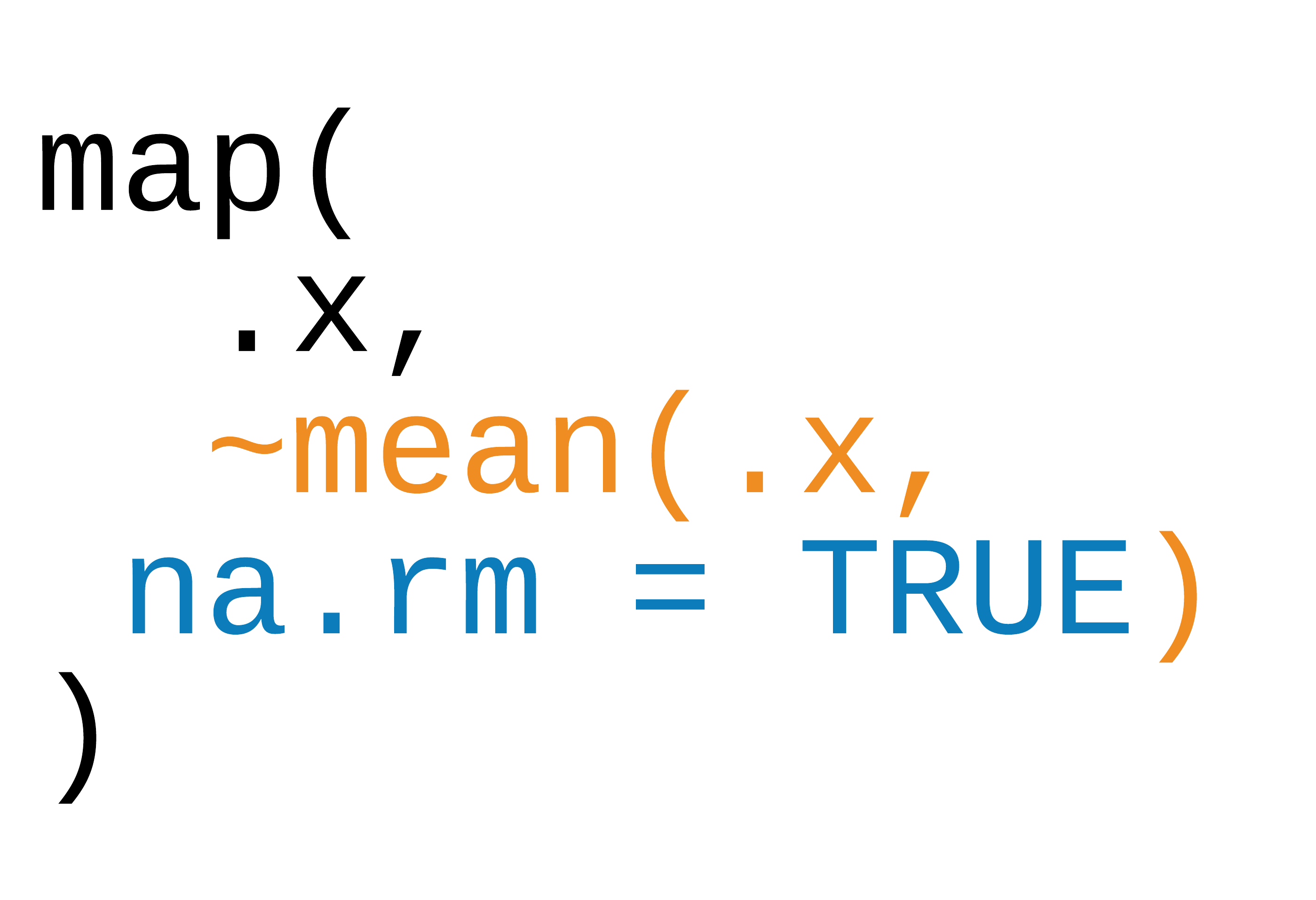
37 / 68
Annonymous functions
## $country## [1] 142## ## $continent## [1] 5## ## $year## [1] 12## ## $lifeExp## [1] 1626## ## $pop## [1] 1704## ## $gdpPercap## [1] 170439 / 68
Returning types
| map | returns |
|---|---|
map() |
list |
map_chr() |
character vector |
map_dbl() |
double vector (numeric) |
map_int() |
integer vector |
map_lgl() |
logical vector |
map_dfc() |
data frame (by column) |
map_dfr() |
data frame (by row) |
40 / 68
Returning types
map_int(gapminder, ~length(unique(.x)))## country continent year lifeExp pop gdpPercap ## 142 5 12 1626 1704 170442 / 68
map2(.x, .y, .f)
43 / 68
map2(.x, .y, .f)
.x, .y: a vector, list, or data frame
43 / 68
map2(.x, .y, .f)
.x, .y: a vector, list, or data frame
.f: a function
43 / 68
map2(.x, .y, .f)
.x, .y: a vector, list, or data frame
.f: a function
Returns a list
43 / 68
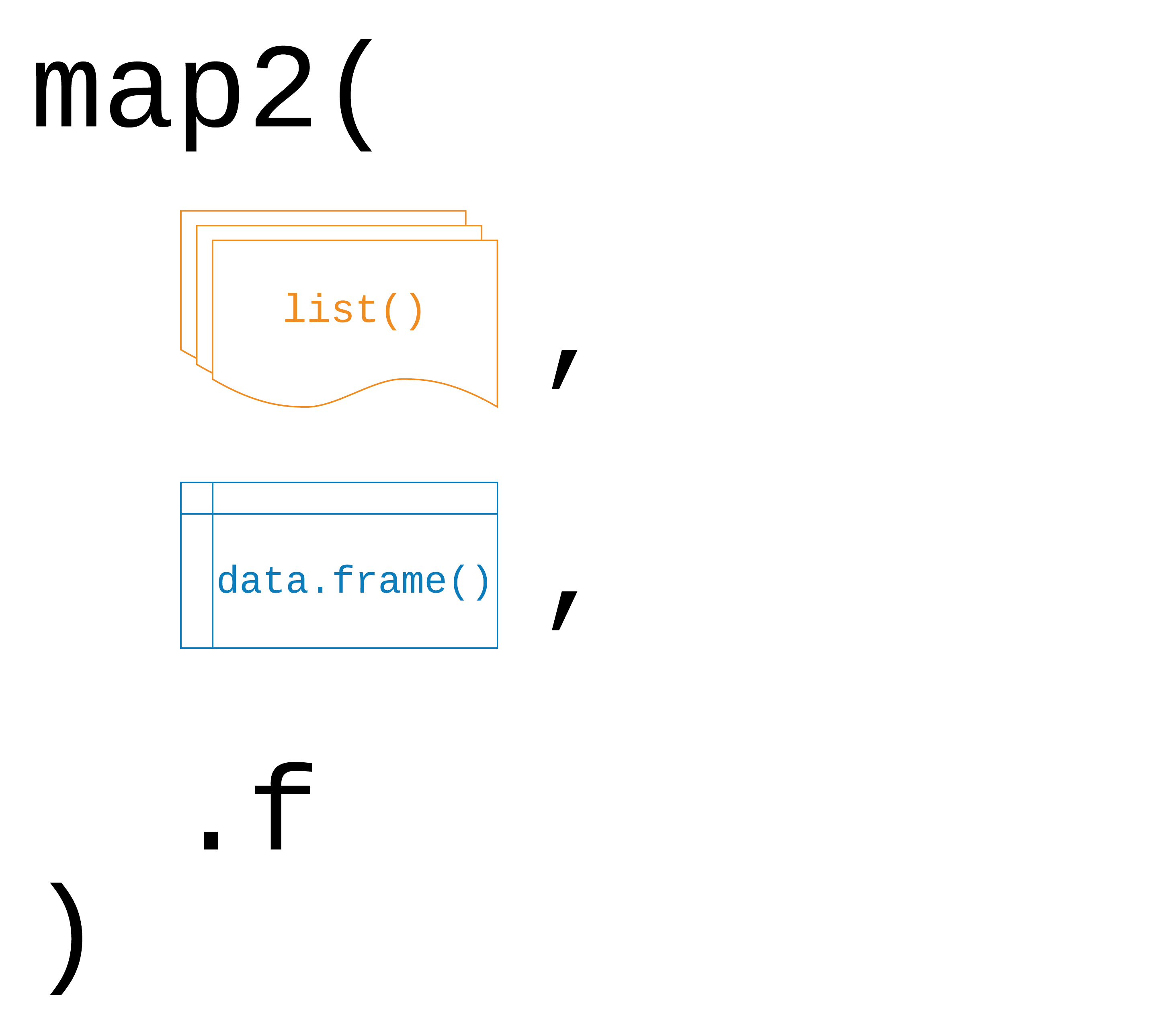
44 / 68
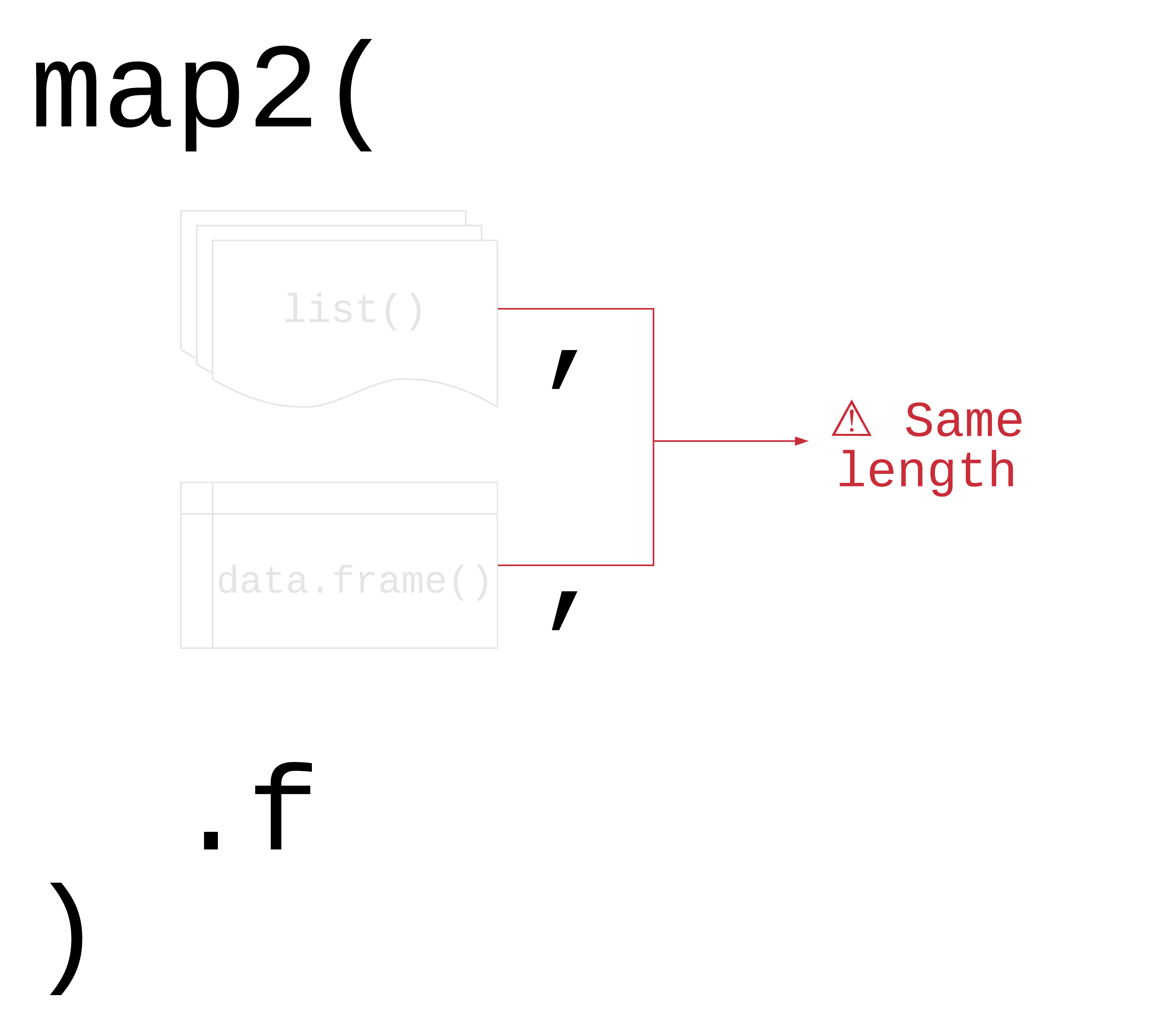
45 / 68
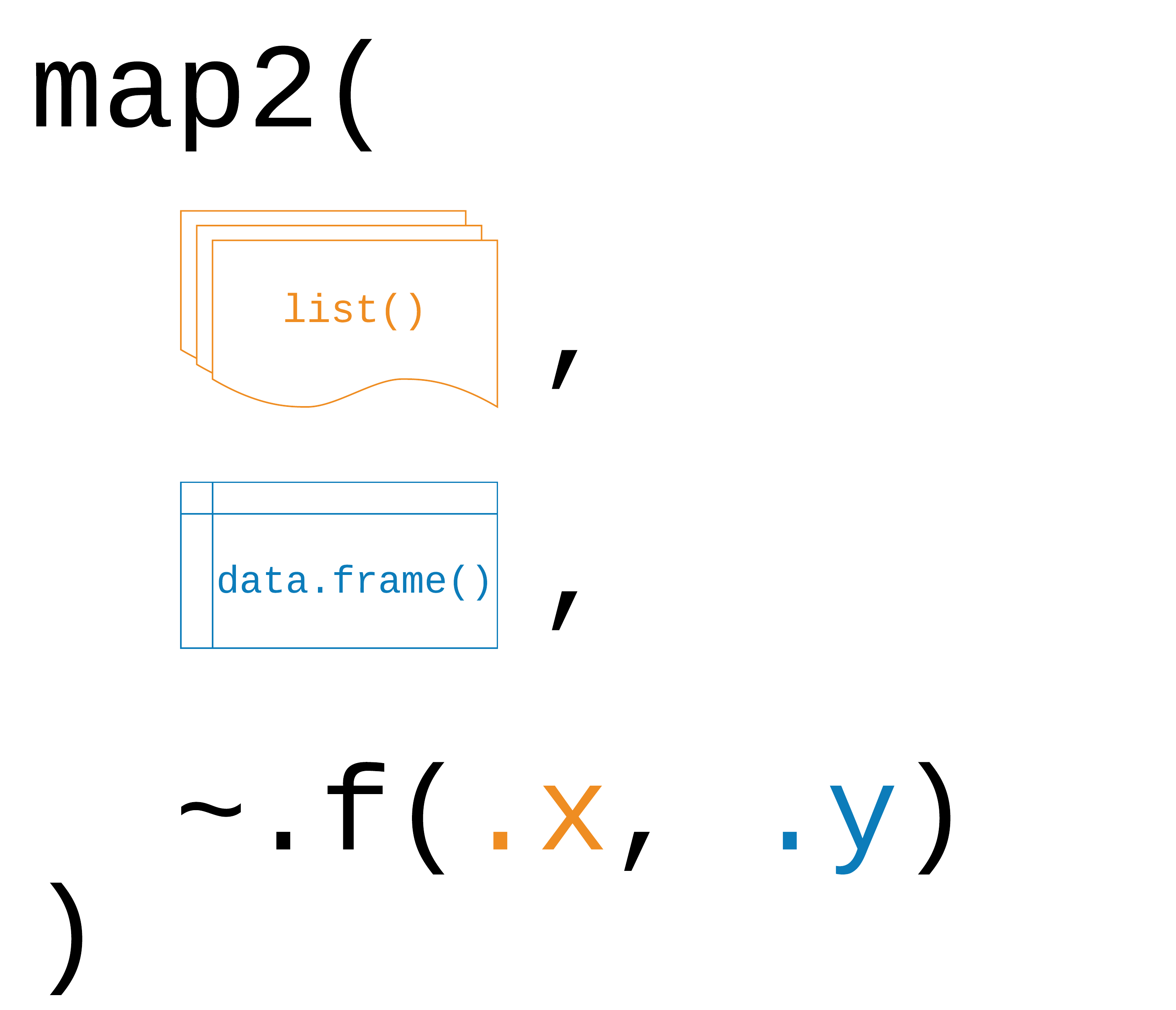
46 / 68
map2()
means <- c(-3, 4, 2, 2.3)sds <- c(.3, 4, 2, 1)map2_dbl(means, sds, rnorm, n = 1)47 / 68
map2()
means <- c(-3, 4, 2, 2.3)sds <- c(.3, 4, 2, 1)map2_dbl(means, sds, rnorm, n = 1)48 / 68
map2()
means <- c(-3, 4, 2, 2.3)sds <- c(.3, 4, 2, 1)map2_dbl(means, sds, rnorm, n = 1)## [1] -2.997932 2.178125 1.266952 2.94828749 / 68
| input 1 | input 2 | returns |
|---|---|---|
map() |
map2() |
list |
map_chr() |
map2_chr() |
character vector |
map_dbl() |
map2_dbl() |
double vector (numeric) |
map_int() |
map2_int() |
integer vector |
map_lgl() |
map2_lgl() |
logical vector |
map_dfc() |
map2_dfc() |
data frame (by column) |
map_dfr() |
map2_dfr() |
data frame (by row) |
50 / 68
Other mapping functions
pmap() and friends: take n lists or data frame with argument names
51 / 68
Other mapping functions
pmap() and friends: take n lists or data frame with argument names
walk() and friends: for side effects like plotting; returns input invisibly
52 / 68
Other mapping functions
pmap() and friends: take n lists or data frame with argument names
walk() and friends: for side effects like plotting; returns input invisibly
imap() and friends: includes counter i
53 / 68
Other mapping functions
pmap() and friends: take n lists or data frame with argument names
walk() and friends: for side effects like plotting; returns input invisibly
imap() and friends: includes counter i
imap_if(), map_at(): Apply only to certain elements
54 / 68
| input 1 | input 2 | input n | returns |
|---|---|---|---|
map() |
map2() |
pmap() |
list |
map_chr() |
map2_chr() |
pmap_chr() |
character vector |
map_dbl() |
map2_dbl() |
pmap_dbl() |
double vector (numeric) |
map_int() |
map2_int() |
pmap_int() |
integer vector |
map_lgl() |
map2_lgl() |
pmap_lgl() |
logical vector |
map_dfc() |
map2_dfc() |
pmap_dfc() |
data frame (by column) |
map_dfr() |
map2_dfr() |
pmap_dfr() |
data frame (by row) |
walk() |
walk2() |
pwalk() |
input (side effects!) |
55 / 68
Base R
| base R | purrr |
|---|---|
lapply() |
map() |
vapply() |
map_*() |
sapply() |
? |
x[] <- lapply() |
map_dfc() |
mapply() |
map2(), pmap() |
56 / 68
Benefits of purrr
- Consistent
- Type-safe
- ~f(.x)
57 / 68
Efficient Loops

58 / 68
Loops vs functional programming
x <- rnorm(10)y <- map(x, mean)x <- rnorm(10)y <- vector("list", length(x))for (i in seq_along(x)) { y[[i]] <- mean(x[[i]])}59 / 68
Loops vs functional programming
x <- rnorm(10)y <- map(x, mean)x <- rnorm(10) y <- vector("list", length(x))for (i in seq_along(x)) { y[[i]] <- mean(x[[i]]) }60 / 68
Loops vs functional programming
x <- rnorm(10)y <- map(x, mean)x <- rnorm(10)y <- vector("list", length(x)) for (i in seq_along(x)) { y[[i]] <- mean(x[[i]]) }61 / 68
Loops vs functional programming
x <- rnorm(10)y <- map(x, mean)x <- rnorm(10)y <- vector("list", length(x)) for (i in seq_along(x)) { y[[i]] <- mean(x[[i]])}62 / 68
Of course someone has to write loops. It doesn’t have to be you.
--Jenny Bryan
63 / 68
Working with lists and nested data

64 / 68
Working with lists and nested data

65 / 68
Adverbs: Modify function behavior
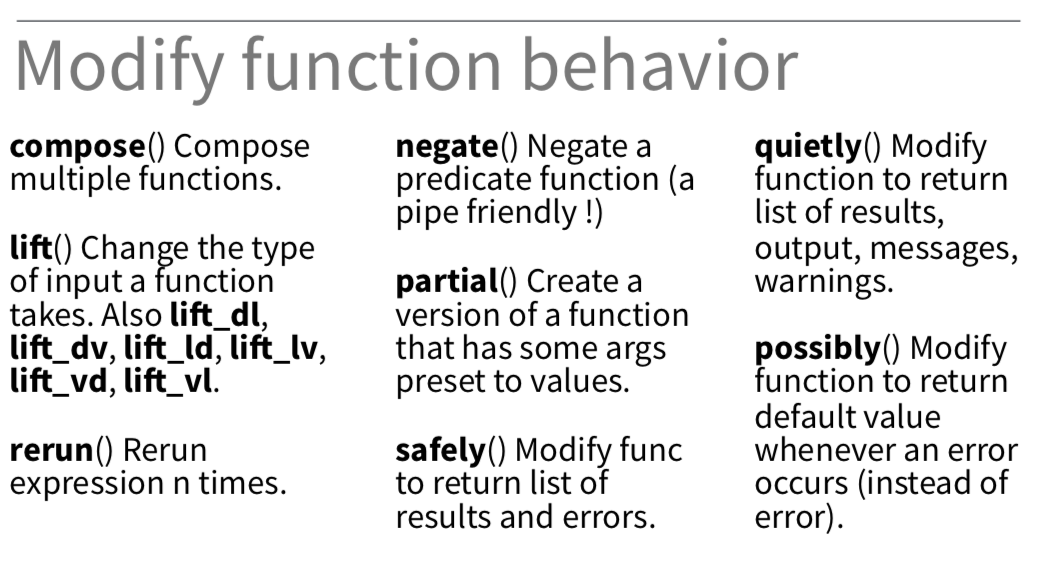
66 / 68
Learn more!
Jenny Bryan's purrr tutorial: A detailed introduction to purrr. Free online.
R for Data Science: A comprehensive but friendly introduction to the tidyverse. Free online.
RStudio Primers: Free, interactive courses, including purrr.
67 / 68
Thanks for coming!
map(kittens, wag_tail)

malcolmbarrett
@malco_barrett
Slides created via the R package xaringan.
68 / 68